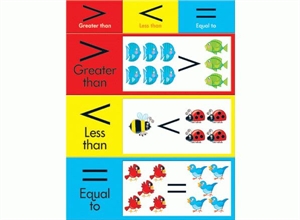
- #Fractions greater than less than equal to song 3r how to
- #Fractions greater than less than equal to song 3r trial
It is between \(4\) and \(5\) on the number line.

Therefore, write down factors of 10:Ĭheck the factors by applying distributive property.\). Now we can find the factors of (x 2 – 7x + 10). Therefore, we need to consider the coefficient of x 2 and the factors of c to find numbers whose sum is b.ĭetermine the common factors of the equation. In this case, we can not solve the quadratic equation by the use of common factors. Sometimes, the leading coefficient of a quadratic equation may be greater than 1. X = -6, -2 Factoring when the coefficient of x 2 is greater than 1 Use distributive property to check the factors Now equate each factor to zero and solve the expression to get Identify factors whose product is 8 and sum is -6 (x + 1) (x – 6) = x 2 – 6 x + x – 6 = x 2 – 5x – 6Įquate each factor to zero and solve to get ĬASE 4: When b is negative and c is positive Now identify factors whose product is -6 and sum is –5:Ĭheck the factors using the distributive property. Therefore, x = 1, x = -5 are the solutions. Verify the factors using the distributive property. Identify the factors whose product is – 5 and sum is 4. Identify two factors with the product of 25 and sum of 10.ĬASE 2: When b is positive and c is negative Therefore, the solution is x = – 2, x = – 5 The factors of the quadratic equation are:(x + 2) (x + 5) Verify the factors using the distributive property of multiplication. Identify two factors with a product of 10 and a sum of 7: Solve the quadratic equation: x 2 + 7x + 10 = 0 You need to identify two numbers whose product and sum are c and b, respectively. To factorize a quadratic equation of the form x 2 + bx + c, the leading coefficient is 1. Factoring when the Coefficient of x 2 is 1
#Fractions greater than less than equal to song 3r trial
Therefore, we will use the trial and error method to get the right factors for the given quadratic equation.
#Fractions greater than less than equal to song 3r how to
In this article, our emphasis will be based on how to factor quadratic equations, in which the coefficient of x 2 is either 1 or greater than 1. The are many methods of factorizing quadratic equations. The fraction with the lesser numerator is the lesser fraction. If the denominators are the same, then the fraction with the greater numerator is the greater fraction. Solve the following quadratic equation (2x – 3) 2 = 25Įxpand the equation (2x – 3) 2 = 25 to get Which fraction is greater than less than If they are different, rewrite one or both fractions with a common denominator.


In other words, we can also say that factorization is the reverse of multiplying out. How to Factor a Quadratic Equation?įactoring a quadratic equation can be defined as the process of breaking the equation into the product of its factors. We can obtain the roots of a quadratic equation by factoring the equation.įor this reason, factorization is a fundamental step towards solving any equation in mathematics. The term ‘a’ is referred to as the leading coefficient, while ‘c’ is the absolute term of f (x).Įvery quadratic equation has two values of the unknown variable, usually known as the roots of the equation (α, β). A quadratic equation is a polynomial of a second degree, usually in the form of f(x) = ax 2 + bx + c where a, b, c, ∈ R, and a ≠ 0. Factoring Quadratic Equations – Methods & Examplesĭo you have any idea about the factorization of polynomials? Since you now have some basic information about polynomials, we will learn how to solve quadratic polynomials by factorization.įirst of all, let’s take a quick review of the quadratic equation.


 0 kommentar(er)
0 kommentar(er)
